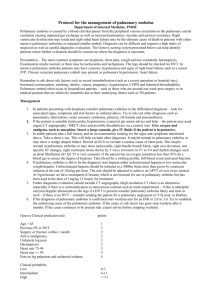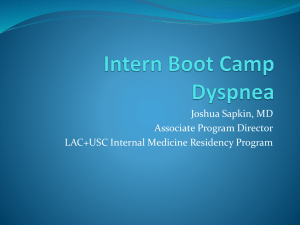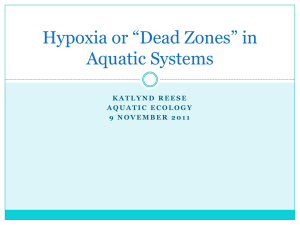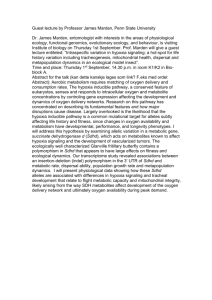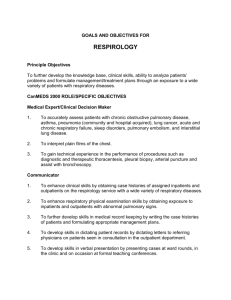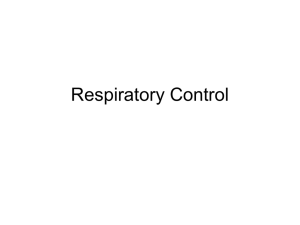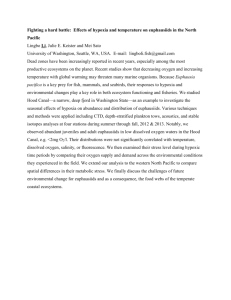Hypoxia MCQ`s
advertisement
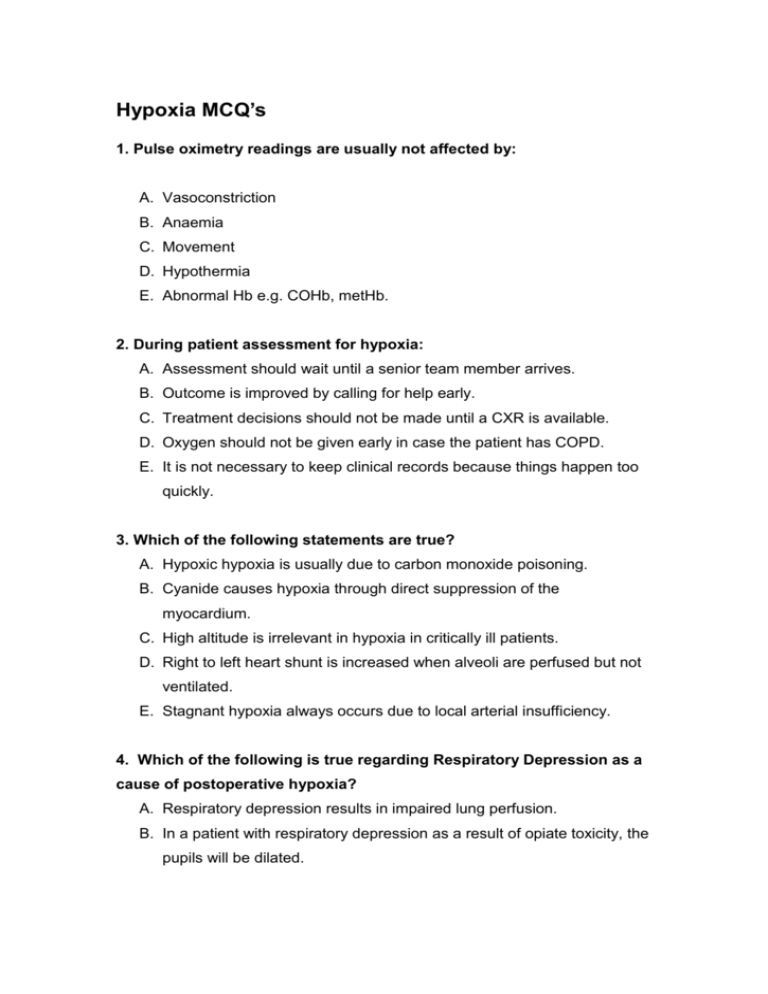
Hypoxia MCQ’s 1. Pulse oximetry readings are usually not affected by: A. Vasoconstriction B. Anaemia C. Movement D. Hypothermia E. Abnormal Hb e.g. COHb, metHb. 2. During patient assessment for hypoxia: A. Assessment should wait until a senior team member arrives. B. Outcome is improved by calling for help early. C. Treatment decisions should not be made until a CXR is available. D. Oxygen should not be given early in case the patient has COPD. E. It is not necessary to keep clinical records because things happen too quickly. 3. Which of the following statements are true? A. Hypoxic hypoxia is usually due to carbon monoxide poisoning. B. Cyanide causes hypoxia through direct suppression of the myocardium. C. High altitude is irrelevant in hypoxia in critically ill patients. D. Right to left heart shunt is increased when alveoli are perfused but not ventilated. E. Stagnant hypoxia always occurs due to local arterial insufficiency. 4. Which of the following is true regarding Respiratory Depression as a cause of postoperative hypoxia? A. Respiratory depression results in impaired lung perfusion. B. In a patient with respiratory depression as a result of opiate toxicity, the pupils will be dilated. C. The opiate antagonist naloxone has a long pharmacological half life, so should be used with care. D. Carbon dioxide narcosis is not a cause of respiratory depression. E. Respiratory depression as a result of opiate toxicity is more likely to occur in patients with renal impairment. 5. Atelectasis: A. Is most commonly seen following lower limb surgery. B. Results in alveolar collapse which leads to hypoxia. C. Should be treated immediately with antibiotics. D. Is caused by aspiration of stomach contents at the time of surgery. E. Is a rare cause of post-operative hypoxia. 6. Which of the following is true regarding Pulmonary Embolus? A. Hypoxia is a result of ventilation/perfusion mismatch. B. Thrombus is the only embolus that can affect the lung. C. Malignancy is not a risk factor for developing pulmonary embolus. D. The presence of atrial fibrillation on an ECG with associated chest pain is pathognomonic of pulmonary embolus. E. D-Dimer is an excellent test to perform in post-operative patient with suspected pulmonary embolus. 7. In the management of pulmonary embolus, which of the following is true? A. Antiplatelet therapy should be given without delay. B. Active gastrointestinal bleeding is not a contraindication to immediate thrombolysis. C. In a stable patient with a confirmed pulmonary embolus, low molecular weight heparin is the treatment of choice. D. Anticoagulation is required in the treatment of fat embolism. E. Thrombolysis is the treatment of choice in a stable patient with an unconfirmed pulmonary embolus. 8. Which of the following is true regarding post-operative pneumonia? A. It is a cause of ventilation/perfusion mismatch. B. It is normally caused by a single bacterial species. C. Culture sensitivities should be awaited before commencing treatment in an unwell patient with postoperative pneumonia. D. Antimicrobial treatment should be based upon local recommendations with respect to bacterial sensitivities and resistance. E. Once antibiotic treatment is commenced, every patient improves significantly. 9. Which of the following is NOT true in ARDS? A. It is characterised by inflamed lung parenchyma. B. It is initiated as part of a systemic inflammatory response syndrome. C. It can normally be managed with supplemental oxygen given at ward level. D. Pulmonary artery wedge pressure is < 18mmHg E. Ventilatory support is invariably required. 10. Which of the following statements is true? A. Hypoventilation affects oxygen tension before it affects CO2 contents in the blood. B. Airway patency should be assessed first in a patient with hypoxia. C. Patients with sickle cell anaemia can manage at low Hb levels because Hb-S can carry more oxygen. D. Above a PaO2 of 8.8 kPa there is a direct correlation between PaO2 and SaO2. E. At high altitude oxygen is mainly carried in blood as a solution.


